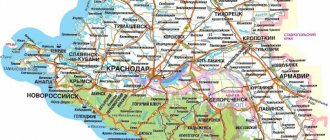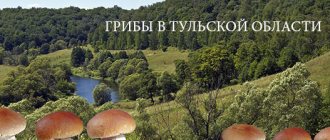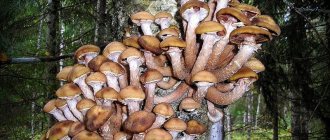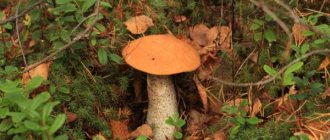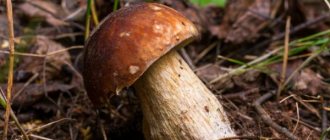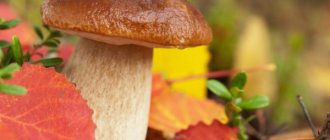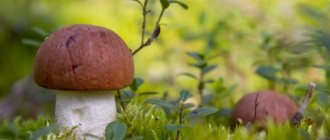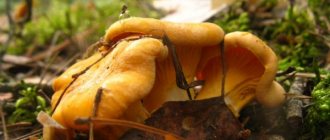The main season for mushroom pickers is autumn. It is at this time that the peak yield of most types of popular mushrooms occurs. But real fans of this type of recreation begin their trips to the forest in spring and summer, especially in the southern regions of Russia, where summer begins the earliest. Therefore, for lovers of quiet hunting, a list of mushroom places in the Krasnodar Territory will be very useful.
Collection time and features of use of mushrooms
In terms of the diversity of mushroom species, the Krasnodar Territory can be compared with the Far East, but the peculiarities of soil and climatic conditions allow the collection of fruiting bodies for quite a long time.
Thousands of lovers of quiet hunting travel through suburban forest belts on weekends. Depending on the species characteristics, mushroom picking can begin as early as May, and the last harvest can be harvested before the onset of significant autumn cooling. Of course, main collection dates are approximate and may vary slightly depending on weather conditions each year.
| Species name | Category | Terms of main collection | Use of fruiting bodies |
| White mushrooms | First | Between May and September | Universal |
| Grabovik | Second | Between July and September | Cooking, frying, stewing, drying |
| Yellow hedgehog | Fourth | Between July and November | Boiling, stewing and frying |
| Oiler grainy | Second | Between April and November | Boiling, frying, stewing, drying, pickling |
| The fox is real | First | Between May and November | Boiling, frying, stewing, marinating |
| Oak milk mushroom | Second | Between June and October | Pickling |
| Green moss | Third | Between May and October | Boiling, frying, stewing, drying, pickling |
| Garlic | Fourth | Between July and September | Cooking, frying, stewing, drying |
According to experienced mushroom pickers, the most favorable mushroom places in the Krasnodar Territory are oak forests near the Ubinka River, as well as the Crimean, Seversky, Apsheronsky and Tuapse regions, Goryachiy Klyuch and the outskirts of the city of Gelendzhik. A significant number of milk mushrooms, aspen mushrooms, boletuses, white mushrooms, moss mushrooms, trumpet mushrooms and white mushrooms grow near Barabinsk. Here, regardless of skill, there is always the opportunity to collect a rich harvest of tasty and healthy mushrooms.
Distribution area and mushroom places
In areas with a humid subtropical climate, in particular in the Krasnodar Territory, edible and very tasty birch bark mushrooms grow on fallen trees. It is important to note that among the tree species of mushrooms there are practically no poisonous ones, which greatly simplifies the collection. Edible goats and flywheels most often grow in conifers.
Oak, hornbeam-oak, pine, fir-beech, beech-fir forests and clearings are rich in porcini mushroom , which can grow either singly or in small groups.
, hornbeam has become widespread which prefers clayey soils and grows both singly and in fairly large groups. Harvesting a large harvest of yellow hedgehog will not be difficult in deciduous and mixed forests, as well as coniferous forests, regardless of the type of soil.
Granular oiler mostly grows in foothill and mountain zones and is most often found in pine and mixed forests with fairly moist soil. There you can also find oak milk mushrooms, which grow in very large groups. Almost everywhere on wood, often rotten, grows a delicious and very popular garlic mushroom.
When and where to go on a “silent hunt”
Mushrooms of Crimea in 2022: the best places and collection season
As in most regions of Russia, Kuban mushroom pickers begin collecting in late summer - early autumn. However, the exact answer to the question of when to pick mushrooms depends on the specific variety. Some are found only in the first half of autumn, when the weather is warmer, others, on the contrary, grow until the first frost. There are also those that grow already in May.
Experienced mushroom pickers know that the best harvest can be harvested in the Absheron and Tuapse regions. Chanterelles, oyster mushrooms, and russula are found here. The more common boletus and honey mushrooms grow in almost all populated areas. Most often, porcini mushrooms are collected on the territory of Saratov, Smolensk, Kaluga villages, and honey mushrooms - in Goryachy Klyuch and in the vicinity of Krasnaya Polyana.
If you love milk mushrooms, then you should go to Dakhovskaya, Smolenskaya or Kaluga Stanitsa. Boletus and boletus grow in forest areas in the vicinity of mountains and in the coastal area.
What do honey mushrooms look like in Kuban? Photo 2022
Answering the question of newcomers about what honey mushrooms look like in the Kuban, I would like to show a photo that offers a visual solution to a difficult question. A visual representation is always better than a given description, in which you should independently imagine and think out the shape, color and size of the mushrooms.
In the photo you can see both young gifts of the forest and adult mushrooms that are overgrown and large in size. Each picture visually tells you which mushrooms can and should be collected, and which ones should be discarded in your favor.
The pictures show autumn, winter and summer honey mushrooms, and also introduce in detail the varieties that grow in different regions of Russia, Ukraine and Belarus. In the list you can also see honey mushrooms in the Kuban, which experienced mushroom pickers have already begun to look for in 2020.
Silent hunt
Mushroom picker calendar for 2022: favorable days for picking
The natural conditions in Kuban are such that absolutely everything grows here - from wheat to berries. Mushrooms were no exception. This is explained by the fact that Kuban’s location covers several climatic zones at once.
Different parts of the Kuban relief are distinguished by their diversity. Deciduous forests here can be abruptly replaced by coniferous ones, black soil is replaced by clay and sandy soils, which turn into rocky mountains. There is even a saying that if you stick a simple stick into the soil of Kuban, it will easily sprout. And this is actually practically true. The unique climate and fertile lands enable a huge variety of plants to develop in the rich soils of the Kuban.
But along with edible mushrooms, inedible ones also grow well. Therefore, harvesting must be taken seriously. During the mushroom season in the Krasnodar Territory, you can harvest without going into the forest. Here they can even grow in a personal plot under apricots or other fruit trees.
When going on a quiet hunt, you need to take a sharp knife, a wicker basket and a stick with you in order to conveniently move apart the foliage. It is not advisable to use plastic bags, buckets and backpacks to collect nature's gifts. In them, the crop can be damaged, and the mushrooms do not breathe there at all, which can adversely affect the taste of the product.
There is only one rule when hunting quietly. It says that if you are in doubt about mushrooms, you should not touch them. Also, when collecting, you need to know that they grow in families, that is, myceliums. And if one of them is found, his relatives are hiding nearby. They should be cut off with a sharp knife along with the stem.
There is one more point you need to pay attention to. Inedible mushrooms often have a pleasant smell
Therefore, the mushroom picker’s rule applies here again - skip an unfamiliar species.
general information
Edible species are distinguished by edibility category:
- 1st and 2nd - contain many nutrients, microelements and vitamins, and are valued by chefs for their high taste and intense aroma.
- 3 and 4 are more common and affordable, universal in the form of additives for protein dishes and dietary recipes. They require compliance with the rules of cleansing and preparation, because... may accumulate toxins.
Myceliums of some edible species have found application in food and perfumery. Specialists use truffle mycelium and tremella fuciformes, creating extracts from them for expensive exclusive fragrances.
Edible mushrooms
Planting tulips in 2022: when to plant, timing, favorable days
Mushroom picking in the Krasnodar region begins early. In mid-April you can find the first harvest, which does not end until late autumn. There are many varieties of mushrooms, and you don’t have to go into the forest to find them. Mushroom places in the Krasnodar region are almost everywhere - you can even find them in your own garden or park.
What edible mushrooms grow in the Krasnodar region:
- Oyster mushrooms. The mushroom appears in early spring in deciduous forests and grows until autumn. They grow in large families of 15-20 in one place. The hat is round in shape, with a diameter of no more than 15 centimeters. The cap becomes flat as it grows. Oyster mushrooms can be brown or pinkish-gray in color. The pulp has a pleasant smell. They grow in the villages of Krepostnaya and Smolenskaya. Oyster mushrooms are not picky; they are even grown at home.
- Green moss. They appear in forests in early May and grow until October. The diameter of the cap is up to 13 centimeters, the color is olive-golden. The hat has a velvet feel to the touch. The pulp is light with a yellow tint. Turns blue when cut. They are common in the regions of Arkhyz in coniferous and oak forests on paths and edges.
- Grainy butter. Small yellow mushrooms. The hat is shaped like a ball, up to 11 centimeters in diameter. If the question arises where mushrooms grow in the Krasnodar region, getting an answer is quite simple. Butterflies grow in Goryachy Spring and Smolenskaya Stanitsa.
- Entoloma garden. They grow from April to May, in forests and forest plantings. The color is brown, the diameter of the cap is up to 13 cm, it is flat and round. Entoloma garden is recognized by its cap: it is wavy at the edges.
- Grabovik. The hat is golden or green-brown, reminiscent of pillows. Its diameter is no more than 11 centimeters. As it grows, the cap cracks and grayish flesh is visible in the cracks. They grow in oak and aspen forests. Growth occurs from the first days of July to the end of September.
- Violet lacquer. The mushroom is easily identified by its small purple cap. They grow in the villages of Kutaisskaya, Kaluga and Krepostnaya from June to September. Only the caps can be eaten.
- Porcini. They grow almost throughout Russia. Kuban is no exception. The cap is brown and can reach 25 centimeters in diameter. The legs are thick and dense. They grow in the villages of Smolenskaya, Saratovskaya, Goryachy Klyuch and Kaluga. The first layer of whites appears in mid-summer in pine and oak forests. They grow until autumn.
- Chanterelles. The color is bright orange. The cap is round, up to 15 centimeters in diameter, with wavy edges. Chanterelles grow in families of 10-15 in one clearing. They grow from June to October throughout the Kuban region in oak and coniferous forests. Mushrooms are rarely worm-bearing and are widely used not only as food, but also in pharmacology.
- Honey mushrooms. They grow from August to December in forests on the roots of trees. The diameter of the cap is up to 11 centimeters, the shape is hemispherical. The color of honey mushrooms is yellow with a grayish tint. The legs are curved, with a white membranous ring. Collected in the districts of Arkhyz and Psebay.
- Boletus. Their color is brown, the flesh is white, and when cut it acquires a blue tint. The diameter of the hat is up to 20 centimeters. Collected in deciduous forests from mid-June to November, near birch and aspen trees.
- Morel. An unsightly but tasty mushroom that grows from May to October. The cap is conical in shape with uneven holes, the edges grow together with the stem. The height of the morel is up to 10 centimeters. They grow in coniferous forests.
- White truffle. A rare and incredibly tasty mushroom. The surface of the truffle is lumpy and looks like a potato. Diameter up to 12 centimeters, color white. They are collected from July to November in the deciduous forests of Kuban.
- Champignon. Collected from early May to October in deciduous forests. The champignons are white, the cap is no more than 13 centimeters in diameter. Most often they grow in circles.
Winter mushroom, or early honey fungus
May in the Rostov region always pleases with warm, almost summer weather and a rich harvest of forest products. These are not only early berries and everyone’s favorite spring flowers - lilies of the valley. The Don land in mid-May can surprise those who are little familiar with the nature of this region with edible mushrooms. What’s even more interesting is that some of them begin to appear long before the snow cover completely disappears.
Winter in these places is quite warm, so closer to the first days of spring, during major thaws, in forest thawed areas you can see small golden-brown caps on dense, tubular-shaped stems. These are winter honey mushrooms, as they are popularly called, or Flammulina velvety-footed.
We collect and eat greenfinch mushrooms Varieties of row mushrooms: photos and descriptions Where to collect mushrooms: Krasnodar region is a great place for quiet hunting Unique mushrooms of the Crimea
It is a parasitic fungus, so you can find winter honey fungus on trees, especially poplars, birches and maples. Flammulina is one of the few species that grows from September to May. During severe frosts, mushrooms freeze but do not die. With the onset of a thaw, whole groups of winter mushrooms can again be seen in the forest.
They are widely used in cooking: fried and served as part of complex side dishes. Flammulina is good for making soups. Some people like to eat pickled, salted and dried winter mushrooms. It is impossible to confuse these mushrooms of the family of rowaceae with their summer counterparts due to the different fruiting periods.
But there are inedible and even poisonous counterparts of flammulina, which you need to know by sight. Gymnopilus versicolor can pose a great danger to human health and life. It is known as the poison moth. This is a double of the winter honey mushroom. However, both types have obvious external differences that cannot be ignored:
- The plates under the cap of the flammulin are rare and have a yellowish-white color, while in the poisonous moth they are frequent with a bright yellow tint.
- The stalk of the flamboyant gymnopile has a characteristic ring in the upper part, which is not found in edible species.
Winter mushrooms are cut off closer to the cap, since the mushroom has a hard stem at the base, unsuitable for consumption. Flammulina pulp is cream-colored. It contains a large amount of nutrients and beneficial microelements that can have an immunostimulating effect and have a beneficial effect on the functioning of the gastrointestinal tract.
This species often grows in gardens and near roads. In the first case, it is capable of causing serious damage to the harvest of fruit trees, as they parasitize the trunks, depriving the crop of useful substances. In the second case, mushrooms are able to absorb and accumulate harmful emissions that enter the soil and atmosphere with exhaust gases. Therefore, it is impossible to collect honey mushrooms near highways and industrial enterprises.
Outwardly attractive, but poisonous plates
The beautiful appearance of mushrooms can be deceiving and even dangerous to human health. Among the lamellar species there are not only edible, but also dangerous varieties that you need to know (Figure 6).
Here are the names and descriptions of the most famous of them:
- Wolfsaw leaf: in appearance, this inedible representative is similar to oyster mushroom and can be found most often on trees. You can distinguish sawfoil from oyster mushroom by the plates, which in the “fake” will be wide with jagged edges. But the surface of the sawfoil cap is covered with a felt skin with small warts. The pulp is very hard and has a bitter taste.
- The breast is olive-black: in young specimens a large cap with a cone shape can be observed, but as it matures it straightens out and becomes dark. Under the hat are thick yellow plates that will darken with age. The leg is thick, squat and brown in color.
- Violin: has an external resemblance to a pepper milk mushroom - there is a funnel in the middle of the cap, the edges are tucked, the surface is covered with a creamy skin. Under the cap there are rare plates. The leg is short and white. The flesh of the violin is very soft, but has a pungent taste.
- Neutral milkweed (oak mushroom): This type of inedible mushroom can be found under oak trees. The cap is concave with a red-brown tint, the color is darker in the center with light rings. The stem matches the color of the cap. The pulp is very oily with a bitter taste.
Figure 6. The attractive appearance of these mushrooms should not mislead you: they are poisonous. In most cases, the inedible specimens described above have an extremely unpleasant smell and taste, so it is unlikely that you will be able to eat a lot of them. However, it is better not to risk poisoning and collect only well-known species.
Mushroom map
The village of Guzeripl, which is located relatively close to Maykop. These two settlements are separated by 76 kilometers. Here, more attention should be paid to the slopes of the Belaya River and the clearings that are located in forests nearby. The number of noble mushrooms here is pleasantly surprising. You can also comb the villages of Dakhovskaya, Kamennomostsky, Pervomaisky, but it’s better to stop near Khamyshki, where it’s convenient to pitch a tent and collect trophies for pickling and pickling. The main thing is not to accidentally wander into the territory of the Caucasus Nature Reserve, where mushroom picking is prohibited. It is better to concentrate in other dense forests, as well as mountain slopes. Chanterelles, porcini mushrooms, and russulas bear fruit well here. The area at the confluence of the Belaya and Kishi rivers, whose terrain may be intimidating at first. However, not far from the rocky rapids in the thickets there are many milk mushrooms, chanterelles, and bull tongue lurking. The mountainous region of Adygea boasts russula, deer horns, boletus, milk mushrooms, porcini mushrooms, and champignons. If you go here in the spring, then it is better to hunt for Morels and Rowers. And if your main goal is to find mushroom glades rich in boletus, then it is better to give preference to mushroom picking at the end of the spring season and in June
Please note that Truffles are rare here.
Tips for lovers of mushroom delicacies
The most dangerous thing in a quiet hunt is not that a poisonous mushroom gets into the basket. It can be removed at home when the crop is sorted. The main thing is to properly prepare the harvest, otherwise poisoning may result from edible mushrooms. To prevent this from happening, you should listen to some recommendations from experienced Krasnodar mushroom pickers:
- When the harvest is delivered to the house, the product should be sorted immediately. Spoiled, broken, or mushrooms with wormholes should be removed immediately; they are unsuitable for food;
- You should absolutely not roll up canned mushrooms with metal lids. In such canned food, the botulism bacillus can develop, which damages the nervous system. The bacilli die only at a temperature of 120 degrees, and under the iron lid they only grow and multiply. Therefore, salted mushrooms are sealed only with a plastic lid;
- pickled canned food can be sealed with any lid. Vinegar, which is included in pickling, can kill any bacteria;
- All mushrooms after sorting must undergo preliminary heat treatment. But before it, it is necessary to clean each fungus from dirt, cut off the stem and rinse well in running water 2 times. Only after this should the mushrooms be cut and boiled 2 times for 20 minutes, and after the first boiling, the water is completely drained and fresh water is added.
There are some more useful tips:
Mushrooms will remain fresh for a longer period if collected in wicker baskets with holes; It is not recommended to harvest along highways and roads. In such places, mushrooms can be unsafe; here they absorb all the toxins and poisons from exhaust gases; it is best to go deeper into the forest; Only clean, strong and healthy specimens are suitable for processing for pickling, salting or drying; if it was not possible to process the product immediately, it is necessary to place it in the refrigerator; all lamellar mushrooms such as russula should be cut only with the stem
This is done so as not to confuse them with poisonous toadstools, which have “skirts” on their legs; You should never purchase canned mushrooms from unfamiliar sellers; It is not recommended to purchase mushrooms along the routes to Dzhugba and Novorossiysk; you must remember that this is unsafe for health; When purchasing mushrooms in supermarkets, you should pay attention to the quality of packaging and the integrity of the product. Don't put your health at risk
If you listen to these recommendations, mushroom delicacies will only delight you.
The most dangerous mushrooms of Kuban are fly agaric, toadstool, and plush cobweb. These mushrooms contain about 6 highly toxic substances. No heat treatment will help get rid of poisons. Therefore, in order not to accidentally collect such gifts from the forest, before a quiet hunt you should learn more about them all. And, of course, study their appearance so that they do not accidentally end up in the basket.
Summer mushrooms of the Krasnodar region
Summer is a period of real forest riot of mushrooms in Kuban. It would be quite difficult to list all the species that can decorate a mushroom picker’s basket in the middle of the summer season, because it would result in a whole scientific work. Therefore, I will limit myself to the most common and massively growing species that form the basis of commercial mushroom collection.
Common boletus
It begins to bear fruit here at the end of May, and its season ends in late autumn. A typical boletus mushroom, tubular, the cap is hemispherical or cushion-shaped, the stem is scaly, smooth or widening at the base, with flesh bluish along the edge. A pleasant feature of these mushrooms in the Krasnodar region is that watery specimens characteristic of the middle zone are almost never found here. In Kuban, almost all boletus mushrooms are dense and elastic. True, the worms also eat them very actively and it can be difficult to find an intact specimen.
Boletus
Around the same time, aspen boletuses, red and yellow-brown varieties, appear in forests and pendants. These are dense tubular mushrooms with a stem covered in black scales, a dense convex cap of yellow, brownish, red or brick colors. Easily distinguished by the intensely blue flesh when broken. In the Kuban, these mushrooms grow especially abundantly on the border of the forest-steppe and subtropical zones, in particular in Krasnaya Polyana. Large populations were also seen in the Belorechensk area. In the Krasnodar Territory you can find truly gigantic specimens of boletus mushrooms; the personal record of the author of this article is a mushroom that fell slightly short of 3.5 kilograms. And without a single worm, as is typical for boletus.
Spring mushrooms
Oyster mushroom
Among local residents, the name “birch bark” is more common. A fungus that parasitizes the wood of deciduous trees. It has peculiar “ear”-shaped caps and a very short or missing stem. Grows in large clumps. In the Krasnodar Territory, it begins to bear fruit from the beginning of May until winter, and guests from other regions of the country are often amazed at the size of the oyster mushroom “families” and its fertility.
Golovach is round
One of the earliest mushrooms in the region, it begins to bear fruit in mid-April. Quite a large mushroom, strongly reminiscent of an ordinary raincoat. It differs in that it has a false stalk, which is part of the general fruiting body. Almost simultaneously with it, the giant bighead, distinguished by its larger size, and the spiny raincoat, a typical spherical raincoat, decorated with small soft spines, appear. All three species are edible only when young.
Gray dung beetle
A low, gray mushroom with an ovoid and later bell-shaped cap, covered with small scales. Unlike other regions, where this type of mushroom mainly accompanies human habitation and agricultural buildings, in the Kuban this mushroom can be found almost everywhere, with the exception of areas with clay soils. This is explained by the rich composition of the soil layer. It begins to bear fruit very early, from the beginning of April.
Common champignon
A fleshy lamellar mushroom with aromatic flesh, a grayish scaly cap, a dense ringed stalk and a pink or brown lamellar layer. In the Krasnodar Territory, its fruiting begins in mid-April, much earlier than other regions. It grows here surprisingly abundantly, sometimes covering entire clearings with its fruiting bodies. I personally, in the vicinity of Apsheronsk, collected three buckets of champignons in 15 minutes at one small forest edge. And this despite the fact that I chose only specimens no larger than 5 centimeters.
Somewhat later, around the beginning of May, another type of champignon appears, field champignons. It is easily distinguished by its anise-scented pulp and white cap with small yellowish spots. In Kuban they grow as abundantly as the common champignon, preferring open space. Very often they can be found on agricultural lands, especially those that are fallow.
Podvishen
A mushroom that resembles a large white or grayish chanterelle with a mealy odor. In the Khadyzhensk region, individual specimens of these mushrooms have been found since mid-April; by the end of the month, cherry blossoms are already bearing fruit abundantly throughout the region.
Porcini
A powerful tubular mushroom with a cylindrical or club-shaped stalk, a convex or pillow-shaped cap and skin color ranging from almost white to brown, depending on the place of growth and climatic conditions. Yes, don’t be surprised - in Kuban it is classified as a spring mushroom. Or, rather, to all-season, since the first specimens appear already in May, and the last finds of porcini mushroom occur even at the end of November. The porcini mushroom is found especially abundantly in the foothills, in open forests.
Moss fly green
A typical representative of moss mushrooms with a velvety cap and yellow flesh that quickly turns blue when damaged. In general, almost all types of moss mushrooms are represented in the Krasnodar Territory, but the green variety appears here first, in mid-April or early May. Its brother, fissured moss, begins to grow a little later, from mid-May.
White truffle
This is a round, irregularly shaped fruiting body, mostly with tubercles or folds, resembling a walnut or potato tuber. Size 4-10 cm (reduces greatly when drying), weight - up to 500 g. Grayish-white surface, then light brownish, smooth, cracked in old age. Fleshy flesh, white when young, then grayish-yellowish. It has a marble pattern on the cut with sinuous dark lines where the bags are located. The fruit body at a young age is without aroma, but when ripe it has a pleasant, fairly strong mushroom taste and aroma.
Early edible species
The most famous mushrooms that can be eaten are difficult to confuse with fly agaric or toadstool, which pose a danger to humans. Even in the photo, the difference between some safe and poisonous names is so obvious that, having encountered these species in nature, even a beginner can easily figure out which find can be put in the basket and which is better to stay away from.
The Krasnodar region is surprising in that May, which is not considered a mushroom month, can bring great luck to lovers of quiet hunting. Warm spring weather combined with high humidity and suitable soil types create favorable conditions for early germination of spores of some species.
To see what mushrooms grow in Kuban in May, just come to any mixed forest in this region and carefully look at the ground, fallen trees and old stumps. It is here that the first edible mushrooms of the Krasnodar region usually appear.
One of the first to notice is birch bark or oyster mushroom. It grows on the bark of trees in large groups. This is a small mushroom that appears already in May. Its fruiting period lasts all summer and autumn. The humid subtropical climate is perfect for birch bark. The harvest of this species is always rich.
The oyster mushroom has an irregularly rounded cap. Over time, it becomes slightly concave in the center. The edges of the upper part of the mushroom are thin and curved inward. The diameter of the cap reaches 5-15 cm. Its color can be pale pink, gray or brownish. The skin is not separated from the fruiting body, the flesh of which is light and has a pleasant mushroom smell. The photo is not very accurately able to convey the shade of oyster mushroom, but it is difficult to confuse it with dangerous species, since poisonous mushrooms do not grow on trees.
Another May mushroom that can be found in Kuban is called “green moss mushroom”. It got its name from the olive-golden color of its cap. It can reach 15 cm in diameter. Young mushrooms have a convex spherical cap. The leg has a lighter shade. The skin of the fruiting body is dry. The flesh turns slightly blue after cutting.
Starting in April, in the forests of the Krasnodar Territory you can find granular oiler, which bears fruit almost until the onset of cold weather. This mushroom has a convex round cap of orange-brown color. After rain it usually becomes slippery, as if oily. Hence the name. The leg is quite short, with a thin mesh.
All edible mushrooms that grow in spring can be fried, boiled, dried, pickled or salted. Their great advantage is that the period of active fruiting of many poisonous species does not coincide with the time of their appearance. This partially reduces the risk of poisoning. But still, the collection of this natural delicacy must be taken very responsibly, even in May.
What mushrooms grow in May in Kuban
Starting in May, you can pick various mushrooms:
- birch bark (oyster mushroom);
- green moss;
- grainy oiler;
- garden entoloma.
One gib is called May. He may appear in a park, in an open area. Other mushrooms of the last spring month:
- Polypore. Only young ones can be eaten, the color is yellow, closer to the root it is gray. The base of the mushroom is solid, connecting the entire emerging family into a single formation.
- Neckleaf . It appears in the cracks of old trees. The shape of the upper part is similar to a leaf.
- The golovach is oblong . The cap is connected to the stem, so it appears to be an elongated head or a thickened stem.
- Pluteus deer. Loves wood waste. It is similar to boletus, but the lower part is more divided into thin walls.
In May, useful boletuses, honey mushrooms, and boletus also appear. They look for sunny clearings and delight forest guests.
False honey fungus
Poisonous mushrooms of the Krasnodar region
Death cap
The most dangerous poisonous mushroom in Russia. It has a hemispherical or outstretched cap of a white, grayish color, sometimes with a green sheen, a pronounced ring on the stem, and a characteristic volva at the base. I strongly recommend that you get acquainted with other signs and differences in the mushroom encyclopedia! In Kuban it begins to bear fruit in June and continues to grow until the first frost.
Entoloma poisonous
Quite large, with a cap up to 16 cm, a lamellar mushroom. The cap is yellowish-white or gray, and has a strong floury odor of the pulp. In Kuban it occurs during September and October, mainly in the foothills. Very poisonous!
Fly agaric red
The most famous, perhaps, is a poisonous mushroom with a bright red cap covered with characteristic white flakes, a white ringed stalk and an ovoid depression at the base. Fortunately, it is rare in the Kuban region, mainly in mountainous areas, and grows from July to September.
Satanic mushroom
Outwardly, it strongly resembles boletus mushrooms, the surface of the cap is white, grayish, the leg is yellow-red, with a bright red mesh pattern. When broken or cut, the flesh quickly turns red, turns blue along the edges, then the flesh returns to its previous white color. The mushroom is not very poisonous, but can cause quite severe stomach upset. On the territory of the Krasnodar Territory it is found quite often and abundantly, which makes it dangerous. Grows everywhere in deciduous forests.
Common champignon
The cap of this mushroom is about 5-10 cm, convex, hemispherical, flat-convex, gray-brown or white, does not change when pressed. The edge is curved, then straight, solid, smooth, thin. Smooth surface, the skin is easily separated from the pulp. The pulp is dense, fleshy, white, slightly pink at the break. The smell and taste are mushroom, pleasant. The plates are frequent, free, at first pink in color, then brownish, brownish and finally dark brown, almost black. They are not recommended for use at this age. The edge of the plate is solid.
The leg is curved or straight, cylindrical, central, narrowed to the base or smooth, solid, thickened, smooth, whitish, matte, dry. The color does not change when pressed. The blanket is in the form of a white, single-layer, fixed ring located on the leg. In this case, there is no common cover.
These tips are also taken into account
Fans of Morels, Moss mushrooms, Honey mushrooms, and Ryzhikov should give preference to the pine forests of Adygea. If your goal is to go home with baskets full of Russula, Milk mushrooms, Boletus or Oyster mushrooms, you should go to forest clearings of deciduous plantings.
For a variety of edible trophies, experienced mushroom pickers are recommended to go to mixed forests.
If a quiet hunt is planned, you cannot go far for the weekend, look for mushrooms in groves or plantings.
It is worth focusing on Chanterelles, since this type of mushroom is unpretentious and can bear fruit in different soils.
Have the mushrooms gone, what they write on the forum?
Nothing has been written for 2022 yet, since the mushroom season here begins in early spring. First, mushroom pickers go for the most frost-resistant types of mushrooms, which can bear fruit even at low temperatures; later in the mushroom meadows you will see more competitors, which means that closer to summer the number of germinating edible trophies increases.
Mushrooms of Adygea 2022 forum is an excellent place for those beginners who need the help of experienced mushroom pickers, for whom it is important to know the main coordinates of hot spots, other useful tips and landmarks.
Silent hunt
The natural conditions in Kuban are such that absolutely everything grows here - from wheat to berries. Mushrooms were no exception. This is explained by the fact that Kuban’s location covers several climatic zones at once.
Different parts of the Kuban relief are distinguished by their diversity. Deciduous forests here can be abruptly replaced by coniferous ones, black soil is replaced by clay and sandy soils, which turn into rocky mountains. There is even a saying that if you stick a simple stick into the soil of Kuban, it will easily sprout. And this is actually practically true. The unique climate and fertile lands enable a huge variety of plants to develop in the rich soils of the Kuban.
But along with edible mushrooms, inedible ones also grow well. Therefore, harvesting must be taken seriously. During the mushroom season in the Krasnodar Territory, you can harvest without going into the forest. Here they can even grow in a personal plot under apricots or other fruit trees.
When going on a quiet hunt, you need to take a sharp knife, a wicker basket and a stick with you in order to conveniently move apart the foliage. It is not advisable to use plastic bags, buckets and backpacks to collect nature's gifts. In them, the crop can be damaged, and the mushrooms do not breathe there at all, which can adversely affect the taste of the product.
There is only one rule when hunting quietly. It says that if you are in doubt about mushrooms, you should not touch them. Also, when collecting, you need to know that they grow in families, that is, myceliums. And if one of them is found, his relatives are hiding nearby. They should be cut off with a sharp knife along with the stem.
There is one more point you need to pay attention to. Inedible mushrooms often have a pleasant smell
Therefore, the mushroom picker’s rule applies here again - skip an unfamiliar species.
The best mushrooms and mushroom places in the Samara region
Collection of autumn honey mushrooms
There are a number of rules that must be followed when collecting. They will prevent spoiled mushrooms from getting into the basket.
When collecting, it is important to avoid damage to the mycelium.
Rules
Honey mushrooms need to be collected only in environmentally friendly places, separated from large industrial enterprises. Harvesting fungi should begin only when conditions suitable for the appearance of fruiting bodies have arisen. Only young fruits can be collected. Old mushrooms with straightened caps are unsuitable for food.
It is best to collect early in the morning. At this time, the fruiting bodies are saturated with dew, so they tolerate transportation better. Mushrooms are placed with their caps down or on their sides. The harvested crop is not stored for long. It should be processed within 3-5 hours after collection.
https://youtube.com/watch?v=eO-hTub3ypo%3F
Methods
There are 2 ways to collect autumn mushrooms. The first involves cutting the fruit in the middle of the stem. You should not cut honey mushrooms at the root - in this case, too much dirt can get on the fruiting bodies. Before placing them in the basket, brush off any leaves that have fallen on them from the surface of the mushrooms.
The twisting method can only be used when collecting free-standing thick-legged autumn mushrooms. You cannot pick out the mushroom. In this case, you need to cut off the contaminated root part before placing the mushroom in the basket. The mycelium site should be covered with foliage and soil.
Poisonous specimen
One of the dangerous mushroom representatives is the pig.
Until some time, it was considered conditionally poisonous and was used in cooking. We consumed pork after a long preparation. It included 72 hours of soaking in water, then heat treatment in the form of boiling for one hour. What mushrooms grow in a pine forest
Today, pig mushroom is officially recognized as a poisonous mushroom. It contains a hazardous toxin that destroys red blood cells and causes acute kidney failure. Its use can be fatal.
Therefore, when going to the forests of Kuban, you need to familiarize yourself with the appearance of potentially dangerous mushrooms.
Autumn mushrooms of the Krasnodar region
In fact, there are few species growing exclusively in the autumn season in Kuban. This is due to the fact that the climate during the mushroom season is quite even, and therefore many species that are considered purely autumn in other regions grow safely here in the summer, and often in the spring.
Violin
A mushroom that looks like a milk mushroom with a flat, depressed or funnel-shaped cap, white or with brown spots. We can easily distinguish it by the characteristic squeaking sound that the cap’s flesh makes when you run it over a nail or tooth. In Kuban it grows for only 2 months, September and October. In different years it may occur in large quantities or not at all. The largest populations are observed in the area of Goryachiy Klyuch and the village of Kaluzhskaya, growing in oak and hornbeam forests.
Poplar row
A lamellar mushroom with a convex, later outstretched cap of a brown, reddish color, sometimes with green spots; in old mushrooms the caps are wavy, irregular in shape, with cracks. A distinctive feature is the mealy taste of the pulp, which is distinctly crunchy on the teeth. One of the latest mushrooms of Kuban, at the same time one of the most widespread and abundant. During the season it is found throughout the region, and is so numerous that it is almost the main pickling mushroom. At the same time, two more types of rows are growing, the earthen row (here it is called “earthy”) and the yellow-red row.
Herbaceous scale
The local name is golden flake (not to be confused with golden flake, which is a completely different species). Large, up to 25 cm in diameter of the cap, a lamellar mushroom of yellow, reddish or orange color, the stem has a ring. This mushroom grows exclusively in October on black soil and is quite rare. In modern literature it is classified as inedible due to the ability to accumulate hydrocyanic acid salts, but local residents continue to use it after preliminary boiling, and not a single case of poisoning has been recorded.
Description of mushrooms listed in the Red Book of the region
Kuban is a region where not only edible fruits grow, which can be collected without fear or restrictions. Here you can also find specimens listed in the Red Book of the Russian Federation. This:
- Summer truffle. Quite a rare and therefore valuable variety of mushrooms. It has a pleasant nutty taste and exquisite aroma.
- The float is crumbling. A rather rare species of fly agaric, which forms mycorrhiza exclusively with alder. It has miniature sizes (its cap rarely grows more than 3 cm in diameter). The flesh is thin-fleshed, and its color is pale ocher-beige or grayish.
- Cobweb is bluish or bluish-blue. Refers to edible mushroom species. But since it is an extremely rare crop, it is prohibited to collect it in the forests of the Kuban, as well as in other regions of Russia. The fruit got its name for its unusually beautiful appearance and bluish-lilac color.
When to collect porcini mushrooms in the Krasnodar region
The fruiting season of porcini mushrooms in the Krasnodar region begins in mid-June and lasts until October. And if weather conditions are favorable for growth already in May, then its collection begins much earlier than usual. Even an experienced mushroom picker dreams of finding such a noble mushroom. After all, the size of its cap can reach up to 20 cm in diameter, with a thickness of up to 7 cm. The smell of the porcini mushroom is very pleasant, and it also looks very beautiful and stately. It is considered universal in cooking and is suitable for any processing process.
The white mushroom grows both in small groups and single specimens. Therefore, if you find one such delicacy, look around and look for its relatives. In the Krasnodar region, porcini mushrooms are harvested when constant warmth and light, soft rains begin, thanks to which the average humidity reaches approximately 50%. The oak forests near the Ubinka River are also considered the most mushroom places.
Kuban is a unique region with complex terrain and a variety of climatic conditions, characteristic of several climatic zones. Thus, the mushrooms of the Krasnodar region include many known and previously unknown species, including those dangerous to human life and health. This circumstance allows us to recommend collecting exclusively well-known and guaranteed edible species.
What does a porcini mushroom look like?
The flora of our planet is incredibly diverse. There are more than one and a half million species of mushrooms alone. However, only a small part of them, called macromycetes, have large bodies. It is these types of mushrooms, visible to humans, that are the object of “silent hunting”. Favorable climatic conditions determine the presence on the territory of the Krasnodar Territory of almost all species of mushrooms growing in the Russian Federation. But not all of them are popular among mushroom pickers. Let's turn to the most recognized, outwardly recognizable and valued species by gourmets. So, more about which ones grow in the Krasnodar region:
The distribution area is mountain and foothill territories of the Krasnodar Territory (Arkhyz, Kamyshanovaya Polyana, Ilsky village, the vicinity of the Laba River). Favorite places of growth are forest glades, replete with fallen trunks of trees of various species, stumps, and rhizomes of living trees extending outward.
Landscapes of the Krasnodar region.
Mushrooms of Adegea and Kuban autumn-winter 2021
Considering the topic “Mushrooms of Kuban 2021”, we can conclude that the fruiting season begins in autumn:
- boletus;
- Chanterelle;
- Boletus;
- Milk mushrooms;
- Ryzhikov;
- Russula;
- Honey mushrooms;
- White mushrooms.
Experienced mushroom pickers, choosing between hunting in spring-summer and autumn-winter, choose the second, and there are good reasons for this. Autumn fruits are different:
- freshness;
- fleshiness;
- less damage from insects and worms.
Mushroom pickers who go out on a quiet hunt in winter can collect honey mushrooms, which, as we said, easily survive frosts. Other types of mushrooms, in smaller quantities, but still, can be found in the coastal area. And yet, lovers of tasty trophies place the main emphasis on honey mushrooms, which, fortunately, do not have harmful and dangerous counterparts.
boletus
Chanterelles in autumn
Boletus
Milk mushrooms
Saffron milk caps
Russula photo
Assumption honey mushrooms
Porcini mushroom family
Having studied all the mushrooms of Kuban 2022, we can say that whenever you go to collect trophies, refuse quiet hunting in areas close to the highways; you do not need to hunt within the city (within small settlements you can, but away from the roadway ).


